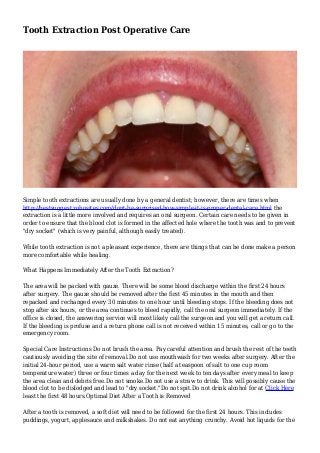
Tooth Extraction Post Operative Care
- 1. Tooth Extraction Post Operative Care Simple tooth extractions are usually done by a general dentist; however, there are times when http://bestsuggest.zohosites.com/dont-be-surprised-how-simple-it-is-proper-dental-care.html the extraction is a little more involved and requires an oral surgeon. Certain care needs to be given in order to ensure that the blood clot is formed in the affected hole where the tooth was and to prevent "dry socket" (which is very painful, although easily treated). While tooth extraction is not a pleasant experience, there are things that can be done make a person more comfortable while healing. What Happens Immediately After the Tooth Extraction? The area will be packed with gauze. There will be some blood discharge within the first 24 hours after surgery. The gauze should be removed after the first 45 minutes in the mouth and then repacked and rechanged every 30 minutes to one hour until bleeding stops. If the bleeding does not stop after six hours, or the area continues to bleed rapidly, call the oral surgeon immediately. If the office is closed, the answering service will most likely call the surgeon and you will get a return call. If the bleeding is profuse and a return phone call is not received within 15 minutes, call or go to the emergency room. Special Care Instructions Do not brush the area. Pay careful attention and brush the rest of the teeth cautiously avoiding the site of removal.Do not use mouthwash for two weeks after surgery. After the initial 24-hour period, use a warm salt water rinse (half a teaspoon of salt to one cup room temperature water) three or four times a day for the next week to ten days after every meal to keep the area clean and debris free.Do not smoke.Do not use a straw to drink. This will possibly cause the blood clot to be dislodged and lead to "dry socket."Do not spit.Do not drink alcohol for at Click Here least the first 48 hours.Optimal Diet After a Tooth is Removed After a tooth is removed, a soft diet will need to be followed for the first 24 hours. This includes puddings, yogurt, applesauce and milkshakes. Do not eat anything crunchy. Avoid hot liquids for the
- 2. first 48 hours. Forty eight hours after surgery, soft foods that don't require much chewing can be eaten, such as mashed potatoes, Jello, Cream of Wheat. Again, nothing that crumbles or can cause damage to the surgical site should be eaten. It's important to drink lots of fluids during this time especially when taking medications. Water is best followed by clear juices. For the next week, continue on a softer food diet, avoiding foods that may crumble and leave debris behind in the socket or foods that are crunchy and may damage healing gum tissue. How Much Pain Should There Be After a Tooth is Pulled? A certain amount of pain is to be expected. Depending upon the procedure, certain pain medications will have been prescribed anywhere from Tylenol to prescription medications. Take these as directed by the surgeon. If there is severe uncontrollable pain that does not subside after taking the prescribed dosage, call the oral surgeon and ask for advice. Pain may last for up to a week, decreasing little by little each day. If it doesn't, call the surgeon's office. Normal Reactions to Tooth RemovalSwelling - Swelling is normal immediately after the surgery and may continue for up to 48 hours. To reduce the swelling, use a cold pack or an ice pack wrapped in a towel for 20 minutes on the site, then 20 minutes off. After the first 24 hours, it is best to switch from the cold packs to moist heat using the same 20 minute intervals. If, after 72 hours the swelling starts again, call the surgeons office and give them all information including medications, food, pain level.Numbness - Numbness in the effected area and immediately surrounding is normal after novacaine has been given. If the numbness after the surgery continues for more than six hours, call the office for further instruction.Skin Discoloration - Sometimes the surface of the face will become discolored similar to a bruise after the surgery. This is normal and will heal in about the same time a normal bruise heals.Fever - A low grade fever after the surgery may happen. This will resolve itself. If however the fever raises above 101 degree F. or continues for more than 48 hours, call the surgeon's office for further instructions. Sutures in Gums Generally one or two stitches per removed tooth will be inserted into the gums for aid in healing the area. Sutures used in the mouth will dissolve within seven to ten days. Don't be afraid to ask questions or call the surgeon's office with any concerns that might arise before or after the surgery. If something doesn't feel right, it's better to err on the side of caution. Sources:
- 3. Great Expressions Dental Centers Dental Technicians- special instructions given 4/22/10